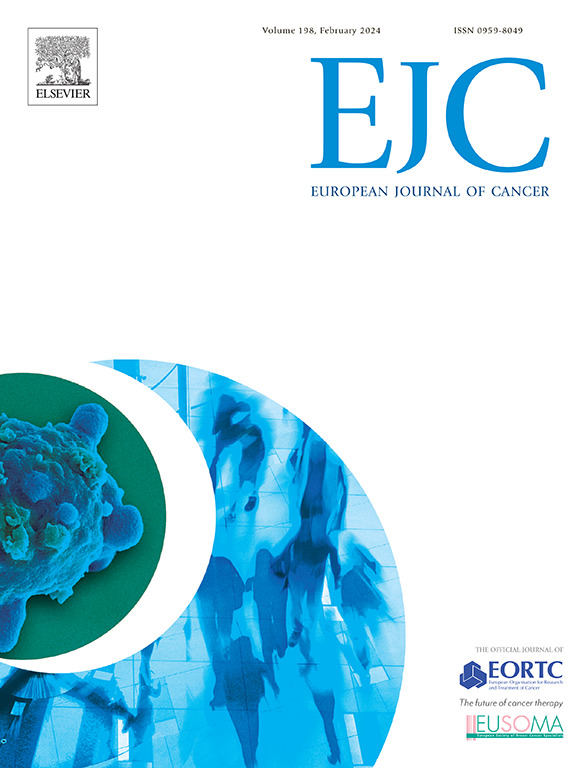卡铂与顺铂的生存结局以及COVID-19对铂选择的影响:一项荷兰小细胞肺癌患者(CACIS)的全国性登记研究。
IF 7.1
1区 医学
Q1 ONCOLOGY
引用次数: 0
摘要
背景:指南推荐顺铂作为一线治疗小细胞肺癌(SCLC)的首选铂类药物,特别是有限期疾病(LS-SCLC)。然而,在2019冠状病毒病大流行期间,由于物流优势,卡铂的使用量可能会增加。我们评估了大流行对荷兰铂类药物使用的影响,并比较了顺铂和卡铂的总生存期(OS)和安全性。方法:使用荷兰癌症登记处的数据,分析2018年至2023年间LS-SCLC和广泛期SCLC (ES-SCLC)的一线铂基治疗。采用单变量和多变量分析评估OS。对3家医院的3-5级治疗相关不良事件进行研究。发现:总体而言,1683年LS-SCLC(卡铂、N = 1011(60 %);顺铂,N = 672[40 %])和3668年ES-SCLC(卡铂、N = 3002[82 %];顺铂,N = 666[18 %])患者包括在内。在大流行期间,卡铂在LS-SCLC和ES-SCLC中的季度使用率分别高达81% %和90% %。在LS-SCLC中,单变量分析显示,卡铂的中位生存期明显短于顺铂(17.9m vs. 26.3m; HR, 1.48; 95 %CI, 1.31-1.68; p )解释:这些发现挑战了长期以来对顺铂优越的看法,支持在SCLC中采用卡铂。本文章由计算机程序翻译,如有差异,请以英文原文为准。
Survival outcomes with carboplatin versus cisplatin and the impact of COVID-19 on platinum choice: A nationwide Netherlands registry study in small cell lung cancer patients (CACIS)
Background
Guidelines recommend cisplatin as the preferred platinum agent in the first-line treatment for small cell lung cancer (SCLC), especially limited-stage disease (LS-SCLC). However, during the COVID-19 pandemic, carboplatin use likely increased due to logistical advantages. We evaluated the pandemic’s impact on platinum agent utilization in the Netherlands and compared overall survival (OS) and safety between cisplatin and carboplatin.
Methods
Using Netherlands Cancer Registry data, first-line platinum-based treatments for LS-SCLC and extensive-stage SCLC (ES-SCLC) between 2018 and 2023 were analyzed. OS was evaluated using univariable and multivariable analyses. Grades 3–5 treatment-related adverse events were studied in three hospitals.
Findings
Overall, 1683 LS-SCLC (carboplatin, N = 1011[60 %]; cisplatin, N = 672[40 %]) and 3668 ES-SCLC (carboplatin, N = 3002[82 %]; cisplatin, N = 666[18 %]) patients were included. During the pandemic, quarterly usage rates of carboplatin reached up to 81 % and 90 % in LS-SCLC and ES-SCLC, respectively. In LS-SCLC, univariable analysis showed significantly shorter median OS with carboplatin compared to cisplatin (17.9m vs. 26.3m; HR, 1.48; 95 %CI, 1.31–1.68; p < 0.001). Similar findings were observed in ES-SCLC (8.0m vs. 9.3m; HR, 1.19; 95 %CI, 1.09–1.30; p < 0.001). However, multivariable analyses, after adjusting for confounders, showed no significant OS differences in either LS-SCLC (HR, 1.06; 95 %CI, 0.90–1.25; p = 0.463) or ES-SCLC (HR, 1.01; 95 %CI, 0.92–1.12; p = 0.785). Confounders were performance status (PS), age, sex, and chemoradiotherapy type for LS-SCLC, and PS, age, sex, stage, and liver metastases for ES-SCLC. Hematologic toxicity was higher with carboplatin, while cisplatin led to more nonhematologic toxicity.
Interpretation
These findings challenge the long-standing belief of cisplatin’s superiority and support the adoption of carboplatin in SCLC.
求助全文
通过发布文献求助,成功后即可免费获取论文全文。
去求助
来源期刊

European Journal of Cancer
医学-肿瘤学
CiteScore
11.50
自引率
4.80%
发文量
953
审稿时长
23 days
期刊介绍:
The European Journal of Cancer (EJC) serves as a comprehensive platform integrating preclinical, digital, translational, and clinical research across the spectrum of cancer. From epidemiology, carcinogenesis, and biology to groundbreaking innovations in cancer treatment and patient care, the journal covers a wide array of topics. We publish original research, reviews, previews, editorial comments, and correspondence, fostering dialogue and advancement in the fight against cancer. Join us in our mission to drive progress and improve outcomes in cancer research and patient care.
 求助内容:
求助内容: 应助结果提醒方式:
应助结果提醒方式:


